Managed design team in launch of Personalized and Streamlined Scheduling in CVS Health ‘Super App’

My Role: Sr. Product Design Manager
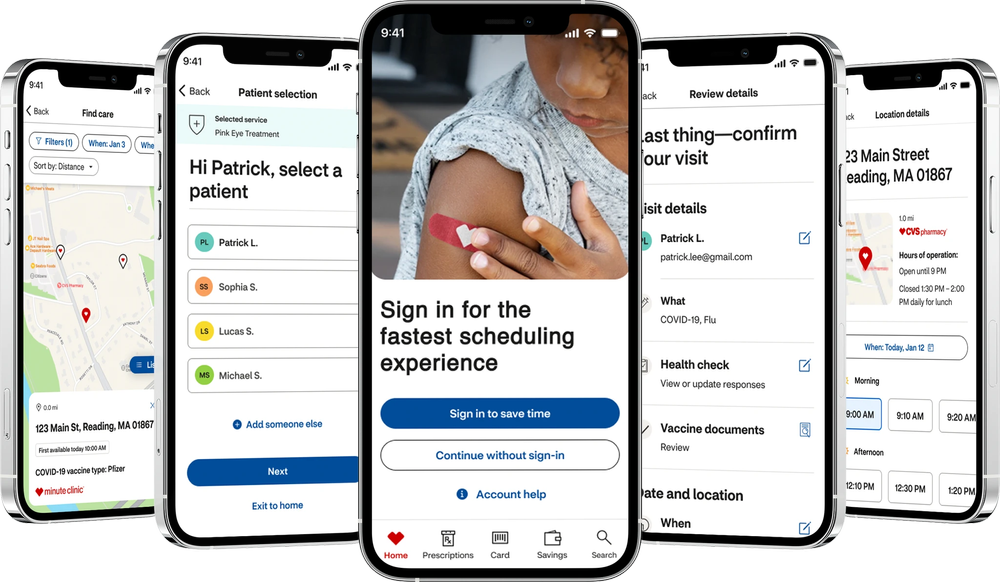
Key Outcomes
Simplified a multi-step scheduling process from fifteen screens to seven, creating a personalized and faster experience for patients to schedule appointments.
- Replaced lengthy flow, requiring input of patient information, with a streamlined and personalized experience for faster scheduling.
- Reimagined clinic locator screen to eliminate early user dead-ends and frustration by displaying only nearby clinics with available appointments.
- Redesigned appointment screens to solve limited future appointment dates by displaying available appointments 28 days in advance.
- Clarified confusing patient eligibility by introducing patient-specific recomended services and plain language.
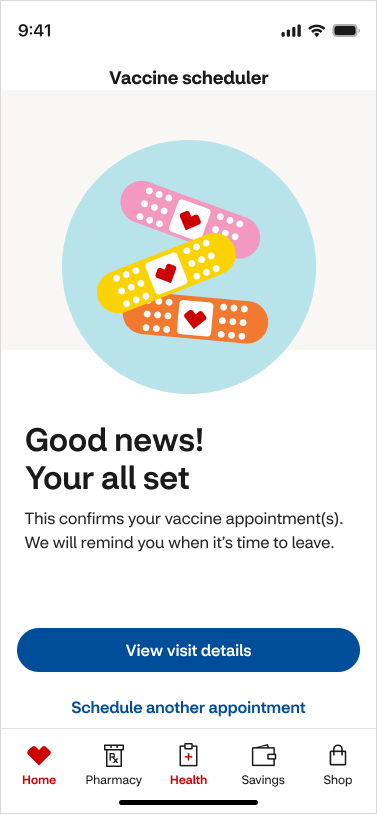
Team Leadership Impact
- Onboarded native app designers to upskill web-based team that improved customization of native components and allowed on-time feature deliveries.
- Cleared confusion about designer roles, responsibilities, and team structure by creating an operational guide for our design team.
- Introduced cross-functional sync that reduced repeated questions, aligned stakeholders, sped up our feedback cycle, and accelerated project momentum.
- Created opportunities to celebrate designer achievements and small wins that inspired and motivated team during rapidly changing product scope and intense executive scrutiny.
- Communicated vision, strategy, and facilitated frequent design reviews, to keep team focused on the right things at the right time.
- Solved QA bottlenecks by instituting and managing a new QA Process for our team that sped up engineering defect remediation and eliminated defect leakage.


“Jay did an outstanding job of managing his team. His contributions to team collaboration, PI Planning, design process optimization and team mentorship were widely praised by colleagues. The successful launch of Next-Gen Scheduling would not have been possible without the work that Jay did to keep the team focused and motivated.”
Ethan Maehl, UX Director
Context & Business Challenge
CVS Health operated fragmented scheduling flows that created operational inefficiencies, a disjointed customer experience, and lingering customer pain points due to technical roadblocks.
Executive leadership established the goal to improve the Brilliant Basics in our Experiences that Matter Most. This included an improved customer scheduling experience with the launch of a new CVS Health Super App.
Success would be measured by delivering a personalized and streamlined scheduling experience in the launch of the new CVS Health Super App, and creating a consistent brand experience across web and native flows for the more than 21 million patients who digitally schedule appointments at CVS Pharmacy and MinuteClinic each year.
My Role & Team
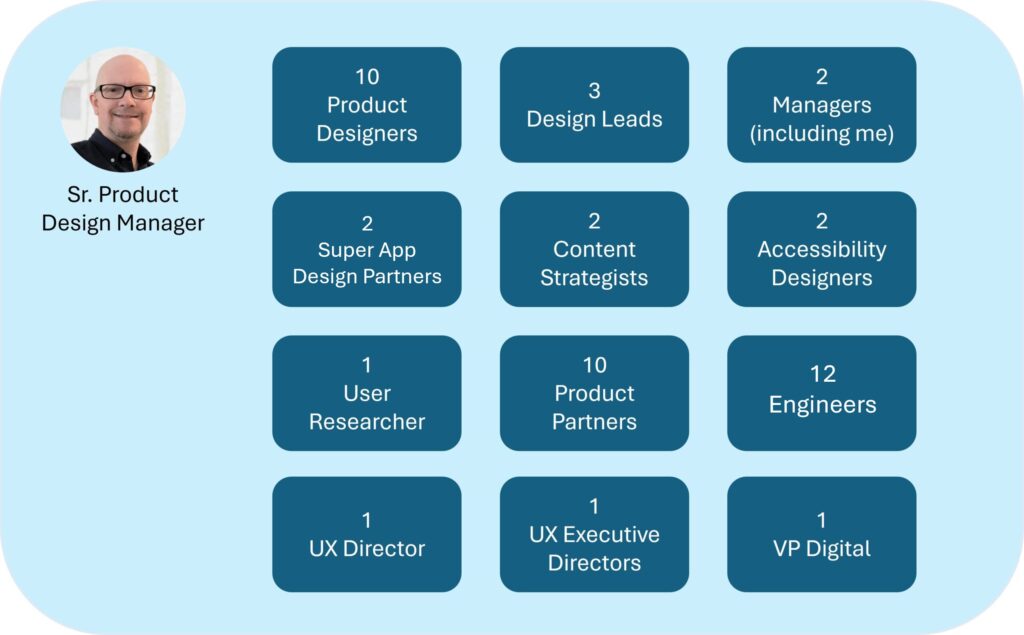

“Jay was such a rock for the Scheduling team. He was always willing to hear out a problem a team member was having, take time out of his day to hop on impromptu calls with designers and always organized in our weekly design team meeting.”
Kevin Allard, Sr. Product Design Manager
Shaping a User-informed Strategy
Our legacy scheduling experiences across Pharmacy and MinuteClinic gave us rich resources for user research and customer analytics. Working with our research and anlytics teams, I led our team’s efforts in defining our Jobs to be done (JBTD) based on Voice of the Customer (VOC), Adobe Analytics, and Quantum Metrics data to identify user pain points.
What users told us
- Didn’t want to enter personal information every time they scheduled an appointment.
- Wanted more personal health care experience.
What data showed us
- 5% of users dropped off date picker screen.
- 45% scheduling conversion rate (below 50% goal).
Leading Key Design Decisions
I advocated relying on our well-established Pharmacy and MinuteClinic user research and analytics to drive our design strategy.
Along with my fellow manager and our design leads we looked to our user data and successfully consolidated conflicting priorities into a unified roadmap, facilitating trade-off discussions and helping executive leadership align on the most critical design features.
New features to reduce required patient information for every visit, solving a significant user paint point, and meeting business objectives to personalize and streamline the experience.
- Incorporate relevant patient details.
- Ability to schedule for dependents or other approved family members.
- Provide personalized vaccine list based on patient eligibility.
- Personalized recommendations based on patient history.
Since our analytics showed users dropping off the date picker screen, we drew on our prior user research and experience with our legacy scheduling flow. To solve customer pain points we would:
- Only show locations with available appointment times.
- Display available appointments up to 28 days in advance.

Onboarding New Designers
Since Scheduling had been web-based and we faced an aggressive timeline, we received commitments to add 3 native app designers to the team. The designers would report to me, along with 2 of our current designers, so it was my responsibility to onboard them to Scheduling.
Onboarding included:
- Welcoming designers to the team with Meet and Greets.
- Orienting new designers to Pharmacy and MinuteClinic Scheduling flow and primary features.
- Establishing designer pairings as two-way knowledge shares between Scheduling designer SMEs and native app specialists to provide upskilling.
Managing Change
Following a significant restructuring, there were many questions and comments from our designers about what was now expected from them.
“With all the recent changes, more is being asked of my role. It seems to change with each quarter.”
“With roles and team structures changing constantly, there are tons of questions as to what is expected of myself and teammates.”
I met with the other design manager and we discussed how best to address designer concerns and crafted an operational guide we presented to the team.
Our guide (“How We Work Together”) cleared confusion about designer roles, responsibilities, and team structure that allowed us to all be on the same page as we moved into our Next Generation Scheduling work.
Setting the Team up for Success
As one of two Design Managers for the team, it was our collective responsibility to align early with our Product and Engineering partners to create and maintain our design delivery workflow.
This involved the two of us intaking, understanding, and assigning the work to the right Designers in order to ensure XDs with the right experience, working style, and skill set were taking on the work.
Pairing the right Designers with the work ensured the best possible end product for our users and meeting our business goals.
Keeping the Trains Running On Time
Because things were moving at such a fast pace, and priorities were shifting frequently, designers quickly became discouraged with the uncertainty of their day-to-day.
It was our job as design managers to keep team morale high. My fellow manager and I agreed to three specific ways we could keep the team moving in a positive direction:
- Offering more time to meet with our designers as a group and maintaining an “open door” policy.
- Recognizing designers achievements and celebrating small wins.
- Helping designers to pace their work by providing clarity on priorities.
User Testing with Constraints
Due to the speed at which we were working, our team was unable to gather detailed feedback from our users for the complex UX scenarios we were solving. Not wanting to launch without user feedback, we opted for unmoderated and recorded user testing sessions.
We quickly iterated to remediate low-performing steps in our flow. Once the product launched, we initiated A/B tests, as well as moderated tests to optimize and add features to the experience.

Iterations after testing
Several participants struggled to view appointment times or missed required input fields due to sticky CTAs blocking required actions.
We removed the sticky CTAs for improved experience.

“Fit & Finish” Quality Assurance
Because of the volume of design work, and tight deadlines, across our 10 XDs, many designs were delivered to our developers all at once! This led to significant QA work needing to be done simultaneously on brand new flows across 4 platforms, leveraging 4 new design toolkits.
Along with the other Design Manager, I instituted a new QA process for our team to alleviate QA bottlenecks.
- 1:1 Designer/Developer pairing, where a Designer and Developer could meet and QA/make code changes in real time.
- Sped up defect remediation process, allowing our Engineering team to get through 500 defects in a matter of weeks.
- Led to 0% defect leakage at launch.

“Jay led tireless efforts in setting expectation for not only design standards, but for process standards as well. Collaboration and communication are key factors to creating accessible design, and he helped create space for important discussions that allowed us to achieve that.”
Joe Shearer, Sr. Accessibility Designer
Delivering a Mobile-first Personalized and Streamlined Unified Scheduling Experience
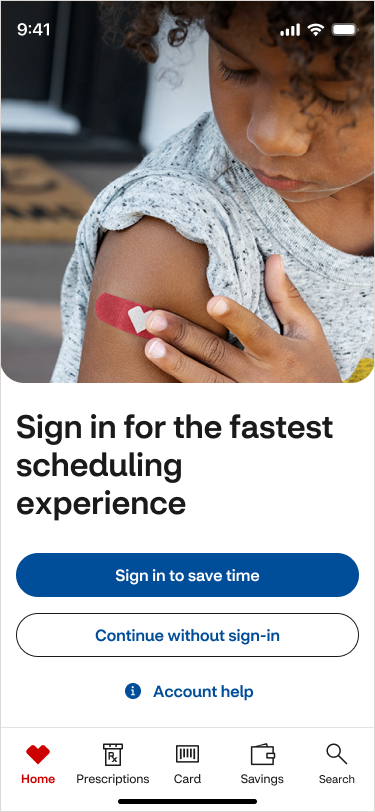



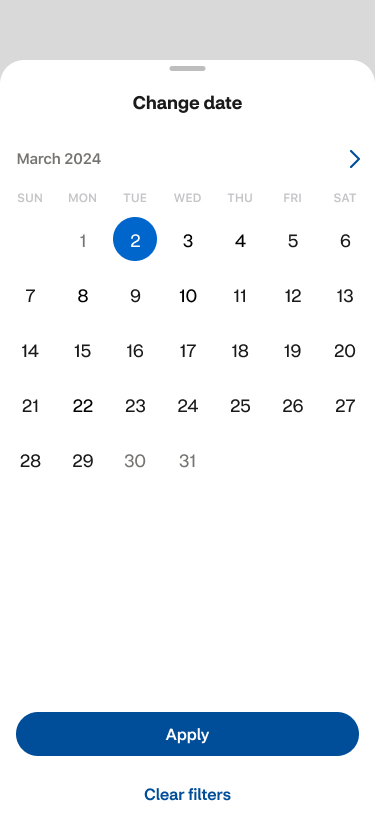



Key Outcomes
Simplified a multi-step scheduling process from fifteen screens to seven, creating a personalized and faster experience for patients to schedule appointments.
- Replaced lengthy flow, requiring input of patient information, with a streamlined and personalized experience for faster scheduling.
- Reimagined clinic locator screen to eliminate early user dead-ends and frustration by displaying only nearby clinics with available appointments.
- Redesigned appointment screens to solve limited future appointment dates by displaying available appointments 28 days in advance.
- Clarified confusing patient eligibility by introducing patient-specific recomended services and plain language.
Team Leadership Impact
- Onboarded native app designers to upskill web-based team that improved customization of native components and allowed on-time feature deliveries.
- Cleared confusion about designer roles, responsibilities, and team structure by creating an operational guide for our design team.
- Introduced cross-functional sync that reduced repeated questions, aligned stakeholders, sped up our feedback cycle, and accelerated project momentum.
- Created opportunities to celebrate designer achievements and small wins that inspired and motivated team during rapidly changing product scope and intense executive scrutiny.
- Communicated vision, strategy, and facilitated frequent design reviews, to keep team focused on the right things at the right time.
- Solved QA bottlenecks by instituting and managing a new QA Process for our team that sped up engineering defect remediation and eliminated defect leakage.

“Jay was a strong leader for our team. He is great at balancing business requirements, technical requirements, and advocating for users with patience and skill. He is an excellent collaborator and someone who is easy to work with, knows his stuff, and is a great resource.”
Chris Gioranino, Sr. Design Lead
